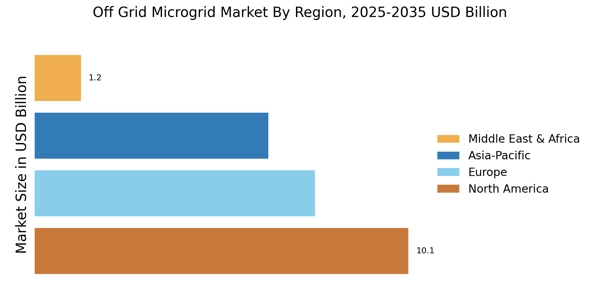Decentralization of Energy Systems
The Off Grid Microgrid Market is witnessing a trend towards the decentralization of energy systems. This shift is driven by the desire for energy independence and resilience against grid failures. Decentralized energy systems empower communities to generate and manage their own energy resources, reducing reliance on centralized power plants. This trend is particularly relevant in regions prone to natural disasters or political instability, where traditional energy infrastructure may be vulnerable. The Off Grid Microgrid Market is well-positioned to capitalize on this trend, offering solutions that enhance local energy autonomy. As more communities recognize the benefits of decentralized energy, the demand for off grid microgrids is expected to rise, fostering innovation and investment in this sector.
Rising Energy Demand in Remote Areas
The Off Grid Microgrid Market is experiencing a surge in demand due to the increasing energy needs of remote and underserved regions. As populations grow and urbanization spreads, many areas remain disconnected from traditional power grids. This situation creates a pressing need for reliable energy solutions. According to recent estimates, nearly 1 billion people lack access to electricity, highlighting a significant market opportunity. Off grid microgrids offer a viable alternative, providing localized energy generation and distribution. These systems can be powered by renewable sources such as solar and wind, which are abundantly available in many remote locations. The ability to deliver energy independence and resilience to these communities positions the Off Grid Microgrid Market as a critical player in addressing energy poverty.
Economic Viability of Off Grid Solutions
The Off Grid Microgrid Market is increasingly recognized for its economic viability. As the costs of renewable energy technologies continue to decline, off grid microgrids are becoming more accessible and affordable for various applications. The levelized cost of electricity from solar and wind sources has decreased significantly, making these options competitive with traditional energy sources. Furthermore, off grid microgrids can reduce transmission and distribution losses, leading to cost savings for consumers. The potential for job creation in the installation and maintenance of these systems also contributes to their economic appeal. As stakeholders seek cost-effective energy solutions, the Off Grid Microgrid Market is likely to see sustained growth, driven by both economic and environmental considerations.
Environmental Sustainability Initiatives
The Off Grid Microgrid Market is increasingly aligned with global sustainability goals. As concerns about climate change intensify, there is a growing emphasis on reducing carbon footprints and promoting environmentally friendly energy solutions. Off grid microgrids, particularly those utilizing renewable energy sources, contribute to this objective by minimizing reliance on fossil fuels. The International Energy Agency has indicated that renewable energy could account for over 80% of the global energy mix by 2050. This shift not only supports environmental sustainability but also enhances energy security. The Off Grid Microgrid Market is thus positioned to play a pivotal role in facilitating this transition, offering innovative solutions that align with both economic and ecological imperatives.
Technological Innovations in Energy Management
The Off Grid Microgrid Market is benefiting from rapid technological advancements in energy management systems. Innovations such as smart grid technology, advanced energy storage solutions, and real-time monitoring systems are enhancing the efficiency and reliability of off grid microgrids. These technologies enable better integration of renewable energy sources, optimizing energy production and consumption. For instance, energy storage systems allow for the balancing of supply and demand, ensuring a consistent energy supply even during periods of low generation. The market for energy storage is projected to grow significantly, with estimates suggesting a compound annual growth rate of over 20% in the coming years. This technological evolution is likely to drive the Off Grid Microgrid Market forward, making it more attractive to investors and stakeholders.


















Leave a Comment